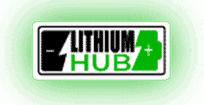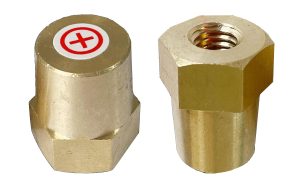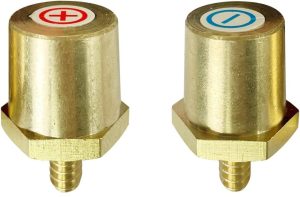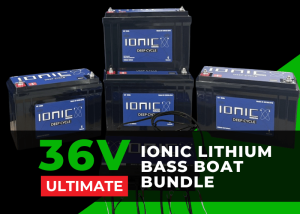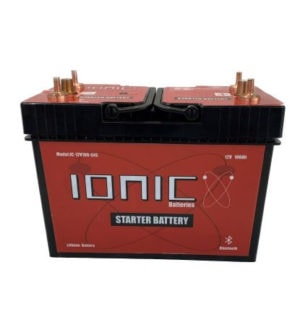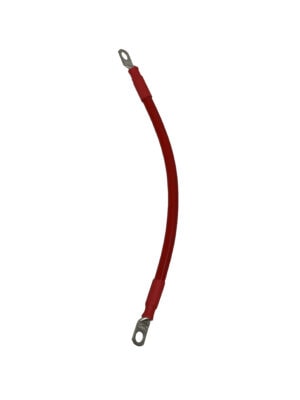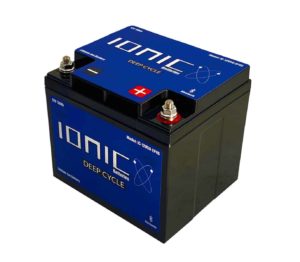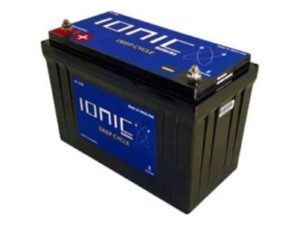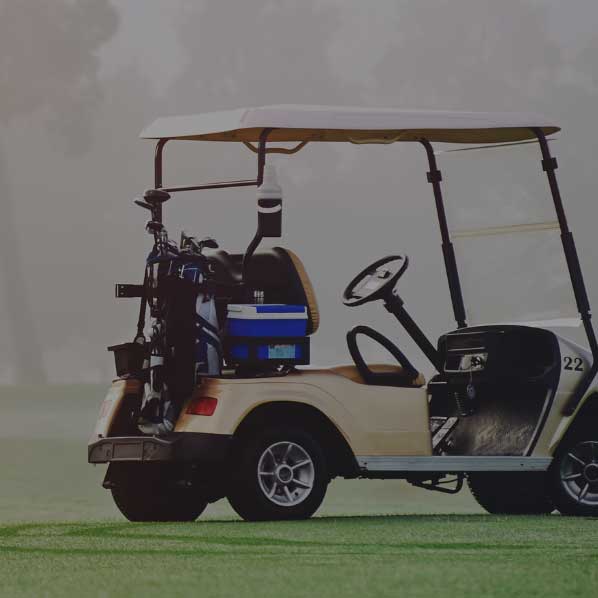Lithium batteries are rechargeable batteries in which lithium ions move from the anode to the cathode during discharging and back when charging. They are popular batteries for use in consumer electronics because they provide high energy density, possess no memory effect and have a slow loss of charge when not in use. These batteries come in a wide variety of shapes and sizes. Compared to lead-acid batteries, Lithium batteries are lighter and provide a higher open circuit voltage, which allows for power transfer at lower currents. These batteries have the following characteristics:
Features of Ionic Lithium Deep Cycle Batteries:
- Light weight, up to 80% less than a conventional, comparable energy storage lead-acid battery.
- Lasts 300-400% longer than lead-acid.
- Lower shelf discharge rate (2% vs. 5-8% /month).
- Drop-in replacement for your OEM battery.
- Expected 8-10 years of battery life.
- No explosive gasses during charging, no acid spills.
- Environmentally friendly, no lead or heavy metals.
- Safe to operate!
The term “Lithium-ion” battery is a general term. There are many different chemistries for lithium-ion batteries including LiCoO2 (cylindrical cell), LiPo, and LiFePO4 (cylindrical/prismatic cell). Ionic mostly focuses on designing, manufacturing and marketing LiFePO4 batteries for its starter and deep cycle batteries.
Lithium Iron Phosphate (LiFePO4) batteries are a type of lithium battery that provide several advantages over traditional lithium-ion batteries based on LiCoO2 chemistry. LiFePO4 batteries provide much higher specific capacity, superior thermal and chemical stability, enhance safety, improve cost performance, enhanced charge and discharge rates, enhanced cycle life and come in a compact, lightweight package. LiFePO4 batteries an offer a cycle life of over 2,000 charge cycles!
All of the Ionic Lithium batteries that LithiumHub sells are LiFePO4 batteries.
Ionic Lithium Deep Cycle Batteries provide multiple advantages over standard lead-acid batteries for energy storage use that we’ll outline below:
- Substantially Lighter – Lithium-ion batteries are just a fraction of the weight of the original lead-acid battery.
- More Powerful – Lithium-ion batteries operate at a higher voltage than standard lead-acid batteries, giving you faster engine speed for longer durations. Lead-acid batteries drop to just 12.5V when only 20% of the battery capacity is used, but lithium-ion batteries provide over 12.8V even when only 20% of the battery capacity is left.
- Low Self-Discharge Rate – Lead-acid batteries lose 4%-25% of their charge every month depending on the quality of the plates and separators used. If you leave a vehicle unattended for a month, the lead-acid battery might lose too much power and the vehicle might not start. On the other hand, our lithium battery chemistry loses less than 3% of charge per month; you can go for several months without having to worry.
- Environmental Friendly – Ionic batteries contain no toxic substances. There is no poisonous lead or corrosive sulfuric acid and as a result, no possible way for an explosive gassing event that is common with lead-acid batteries. In addition, there is no need to maintain acid levels or worry about venting like traditional lead-acid batteries do. The only maintenance that ionic batteries require is ensuring that the battery never drains beyond 80% to ensure optimal life.
- Long Lasting – Cheap lead-acid batteries usually only last 1 to 2 years while gel and AGM lead-acid batteries last 3-5 years with proper maintenance. However, ionic’s lithium-ion batteries can provide 8-10 years of use, easily exceeding the life of any lead-acid battery. Battery life depends purely on proper operation and maintenance, so use common-sense and ensure the battery does not drain beyond 80% discharge. If you are replacing a lead-acid battery in two years or less due to deep cycling damage, you will save money in the long run moving to a ionic lithium-ion
- Fast Recharging – Ionic’s lithium batteries can accept charge current at up to 5 times faster than a lead-acid battery. What’s more, the charge efficiency is about 75% for lead-acid in contrast to 97% for Ionic’s lithium battery. That means less energy is needed to charge and causes less strain on your alternator.
Use pin numbers 0000 or 1234

It will come back on when the battery detects no issues within 30 seconds. If the battery has been discharged to 0% then you may have to jump it from another battery for 3 seconds to wake it up so it will take a charge with lead acid chargers. Using ionic lithium chargers you do not have to wake up the battery with another one. The ionic lithium charger wakes up the batteries automatically.
Yes, you can.
Yes, you can.
We have options available including three 12V 50Ah batteries or one 36V 50Ah battery.
For more information about which might be right for you, check out our article outlining the pros and cons of running each.
If you fish tournaments, I would use the 100Ah batteries for trolling and a 125Ah for starting. If you are a weekend fisherman you can use the 50Ah battery.
Yes, you can. However, the Lithium battery will drain into the AGM as the resting voltage for AGM is lower than the lithium. That would take several weeks but if charged and used weekly the two types of batteries can be put in parallel.
If your charger puts out 14.2 to 14.6 volts to the battery when charging on the AGM setting it will work. Do not use chargers with “desulfation” mode or equalizer mode that charges above 15V.
A fully charged lithium-ion battery can sit for a year or more and still retain adequate capacity, without damaging the battery. As such, any electrical device that has no current flowing when OFF should never need a tender. However, some equipment may have a significant draw even when OFF, to maintain clocks, computers, navigation systems, pumps etc. Thus, ionic recommends using a ionic lithium-ion charger sold at Lithiumhub.
Ionic’s lithium-ion battery chargers have been designed to work together with the internal cell balancing board and BMS in the “Deep Cycle” batteries that have special algorithms to prevent over-charge and maximize life of the battery. We have a very simply approach where all the cell balancing maintenance is done automatically when the charger is attached. NO expensive, complicated charger/tender is needed.
LithiumHub recommends using Ionic chargers with the Ionic batteries. However, lead-acid chargers for Ionic (LiFePO4) batteries can work. Lead-acid batteries charge at 2.30V to 2.45V per cell whereas Ionic (LiFePO4) batteries require 3.60V per cell. Your battery would potentially be undercharged, so you will not get use of the full capacity of the (LiFePO4) battery, nor will balancing be triggered in the (LiFePO4) battery pack, both of which are not desired. Furthermore, the floating charge of the lead-acid charger is not expected by the battery and can cause problems.
If you charge your lithium deep cycle battery above 15V for 12V battery, the BMS inside the battery terminal will turn off. The cut-off voltage settings will vary slightly depending on current levels, temperature and part tolerances. To turn ON the battery again, disconnect the charging source and let the battery rest for several seconds (~30 sec) it should come on. In the event the 12V battery had voltages higher than 18V, the internal BMS is damaged and will not turn ON.
Yes, but you need to make sure the open voltage of the solar panel is below 18V for a 12V battery. It is best if your solar panel has a voltage regulator to stop charging at 14.4V or (LiFePO4) setting of 14.6V.
If you charge your lithium deep cycle battery above 15V for 12V battery, the BMS inside the battery terminal will turn off.
The cut-off voltage settings will vary slightly depending on current levels, temperature and part tolerances. To turn ON the battery again, disconnect the charging source and let the battery rest for several seconds (~30 sec). In the event the 12V battery had voltages higher than 18V when turned off, the internal BMS is damaged and will not turn ON.
Battery life for a lithium battery can be enhanced by not discharging the battery to 1Ah capacity or BMS lower voltage cut-off settings. Discharging down to BMS lower voltage cut-off settings can quickly decrease the life of the battery. Instead, we advise discharging down to 20% capacity remaining then re-charging the battery.
There are several factors that affect the life of a battery. Weather, temperature, recharge cycles, depth of discharge (DOD), discharge current, charging current, charging method, vibration and duration of static use can all have dramatic effects on battery life. A properly maintained Lithium Deep Cycle Battery should last roughly three times as long as lead-acid battery used in similar conditions. Life expectancy is typically 10+ years, and our batteries (30Ah and up) are covered by an 11 year warranty." Learn more here.
These batteries are designed and developed to be used for lower discharge current applications. The 125Ah (125Ah Heater) equivalence to 900 cranking amps can be used start 150 to 250 hp. The 100Ah equivalence to 900 cranking amps can be used to start up to 150 hp. The smaller batteries like the 6Ah, 9Ah, 12Ah, 20Ah, 30Ah and 50Ah can NOT be used to start engines with. If you have a question about applications please call 704-360-9311 or email info@lithiumhub.com and our customer service professionals will be happy to help.
Ionic utilizes the latest advancements in lithium battery technology along with custom features to provide you with the best battery for your vehicle:
In most cases, YES but not for engine starting applications. The Lithium Deep Cycle Battery will perform as a direct replacement for your lead-acid battery for 12V systems. Our battery cases match a lot of OEM battery case sizes.
Yes. There are no liquids in the Lithium Deep Cycle batteries. Because the chemistry is a solid, the battery can be mounted in any direction and there are no worries about lead plates cracking from vibration.
Ionic deep cycle lithium batteries have built in cold weather protection - Does not take a charge if temperatures are below -4C or 24F in our case. Some variations with part tolerances.
Our Ionic heater deep cycle batteries warm up the battery to enable a charger once battery is warmed up.
Lithium deep cycle battery life can be enhanced by not discharging the battery to 1Ah capacity or BMS lower voltage cut-off settings. Discharging down to BMS lower voltage cut-off settings can quickly decrease the life of the battery. Instead, we advise discharging down to 20% capacity remaining then re-charging the battery.
Make sure the load is not exceeding the rated continuous output current. If the electrical load exceeds the limits of the BMS, the BMS will shut down the pack. To reset, disconnect the electrical load and troubleshoot your load and make sure that the continuous current is less than the maximum continuous current for the pack. To reset the pack, attach the charger back to the battery for a few seconds. If you need a battery with additional current output, please contact us at info@lithiumhub.com or call us at 704-360-9311
They can not be put completely under water. Water can be splashed on them and they will be okay.
Ionic’s Deep Cycle Batteries have true lithium capacity rating at 1C discharge rate meaning a 12Ah deep cycle lithium battery will be able to provide 12A for 1 hour. On the other hand, most lead-acid batteries have a 20hr or 25hr rating printed for its Ah capacity meaning the same 12Ah lead-acid battery discharging in 1 hour would typically only provide 6Ah of useable energy. Going below 50% DOD will damage a lead-acid battery, even if they claim to be a deep discharge battery. Thus a 12Ah lithium battery would perform closer to a 48Ah lead-acid battery rating for higher discharge currents and life performance.
Ionic’s Lithium Deep Cycle Batteries have 1/3 the internal resistance of a similar capacity lead-acid battery and they can be safely discharged to 90% DOD. Lead-acid internal resistance rises as they are discharged; the actual capacity which can be used may be as little as 20% of the mfg. rating. Discharging in excess will damage the lead-acid battery. Ionic’s lithium batteries hold a higher voltage during discharge.
No, you cannot turn off the battery or change the BMS board.
Equivalent to a 900A cranking battery
No. One of the advantages to the Lithium Iron Phosphate (LiFePO4) chemistry is that it generates its own internal heat energy. The outside heat of the battery pack itself will get no warmer than a lead-acid equivalent in normal use.
Every battery of ANY chemistry has the potential to fail, sometimes catastrophically or catch on fire. In addition, lithium metal batteries which are more volatile, that are non-rechargeable, are not to be confused with lithium-ion batteries. However, the lithium-ion chemistry used in Ionic Lithium Deep Cycle Batteries, lithium iron phosphate cells (LiFePO4) is the safest on the market having the highest thermal runaway threshold temperature from all the different lithium type of batteries. Remember, there are many lithium-ion chemistries and variations. Some are more volatile than others, but all have made advances in recent years. Also note, that all lithium batteries undergo rigorous UN testing before they can be shipped worldwide further insuring their safety.
At the moment, Lithium materials are about 3~4 times higher than lead-acid for the same capacity. This will no doubt come down as worldwide supply goes up.
We have no solid introduction date in mind for automotive versions at this time, but we do plan on having more battery models available in the near future to be used in cars as well. The higher PB eqv Ah batteries will start vehicles, but will have limited reserve energy.
We currently do not have any prostaff programs in place.
Lithium Deep Cycle Batteries are subject to disposal and recycling regulations that vary by country and region. Always check and follow your applicable regulations before disposing of any battery. Many countries prohibit the disposal of waste electronic equipment in standard waste receptacles. Place only discharged batteries in a battery collection container. Use electrical tape or other approved covering over the battery connection points to prevent short circuits.
Consumers can find the nearest participating drop-off location by going online at www.call2recycle.org or www.rbrc.org or calling 1-877-2-RECYCLE or 1-800-8-BATTERY.
Ionic deep cycle lithium batteries have built in cold weather protection - The battery will not take a charge if temperatures are below -4C or 24F in our case. Some variations with part tolerances.
Our Ionic heater deep cycle batteries warm up the battery to enable a charger once battery is warmed up.
These are the chargers and settings that we recommend to customers.
If your charger puts out 14.2 to 14.6 volts to the battery when charging on the AGM setting it will charge with Ionic lithium batteries.
Do not use chargers with “desulfation” mode or equalizer mode that charges above 15V.
Below are some specific brands and models that are confirmed to work with Ionic lithium batteries. Other models will not charge the batteries completely.
- Ionic
- NOCO GenPro
- Dual Pro PS/Auto
- Minnkota Precision
- Pro Mariner/Pro Tournament Elite
- Stealth
- Troll Bridge DC
- Power Pole
- Minnkota Lithium Charger
*Minnkota Precision does not work on 24V or 36V batteries
If you're going to store your lithium battery for extended periods of time without using it, it's best to charge the battery up to 14.6 volts (100% state of charge) before you store it in any temperature between 23°F and 95°F (-5 °C - 35 °C). If you plan on storing for more than three months, a range from 32-77 ± F (0 - 25± C ) is recommended. A partial state of charge is nothing to be concerned about with lithium batteries.
Cold temperatures can be a battery's worst enemy – luckily, Ionic LiFePO4 batteries are more resilient to colder temps than lead-acid batteries. As such, the cells retain their capacity and voltage far better than traditional lead-acid ones when the temperature drops. If you're charging in below freezing conditions (below 0°C or 32F), make sure to cut your current all the way down to .0lC; If it's under 14° F (-10° C) it has to drop even further, down to .05C. Following this rule will save keep your Ionic Lithium Battery happy for the long haul.
For safety reasons, the charger times out and stops charging after 72 hours of continuous use. This is indicated by blinking red LEDs. To activate the charger again, simple disconnect and reconnect the power cable.
Well, there's a world of valuable LiFePO4 info, and we can only uncover so much. But these articles will answer many important questions:
- Trickle Chargers: Do I Need One?
- Corroded Battery Terminal? How to Avoid it
- Amp Hours to Watt Hours: What’s the Difference?
- What are the Uses & Benefits of 48V LiFeP04 Batteries?
- Why You Need Emergency Battery Backup Power
- The 12V Battery: Finding the Best Option for You
- Lithium Trolling Motor Batteries Info
- What’s A Bluetooth Battery Monitor?
- 48 Volt Battery Info
- Lithium Vs. AGM – A Battery Showdown
- What Is Battery Protection Mode & Do All Batteries Have It?
- How To Upgrade Your Golf Cart To Lithium Batteries
- How To Upgrade Your RV To Lithium Batteries
- Your Best Bet For An Off-Grid Battery Bank
- Considering A Dual-Purpose Marine Battery? Here's What You Need to Know
- What's the Best Marine Battery Charger?
- Choosing The Right Boat Batteries – Which One Should You Pick?
- Your Guide To Choosing The Best RV Battery
- Finding The Best Golf Cart Batteries
- How Long Do Lawn Mower Batteries Last?
- Best UTV Accessories + Absolute Must-Haves
- Lithium: The Best Riding Lawn Mower Battery
- What Are Lithium Batteries Used For? LiFePO4 Batteries Uses
- Choosing The Best Fish Finder Battery
- What Are The Different Types Of Marine Batteries?
- How To Charge RV Batteries
- 36V Trolling and starting options
- Motorhome Batteries – What You Need To Know
- LithiumHub Golf Cart Battery Charger Info
- Thinking About Installing A Kayak Trolling Motor Battery?
- Get Ready For Spring – Tips For Dewinterizing An RV!
- How a Lightweight Deep Cycle Battery Boosts Performance
- What’s The Best Marine Battery Charger?
- How To Charge RV Batteries Safely & Effectively
- Choosing The Right Travel Trailer Battery – The Basics
- Lithium Battery Bank – How Much Capacity Do I Need?
- Camper Must Haves & Coolest Gadgets For The Campground
- Snowbird RVing Tips – Best Destinations, Equipment, & More
- Lithiumhub Emergency Starter Info
- Lithium Batteries In Cold Weather – Everything You Need to Know
- Choosing The Best Battery Tray For Your Boat Or RV
- Series vs. Parallel Info
- Find Your Perfect Boat Battery Charger
- What’s the Best Smart Battery Charger for Deep Cycle Batteries?
- How to Charge a Deep Cycle Marine Battery
- The Best Golf Cart Battery: Lithium Or Lead Acid?
- What’s a Deep Cycle Marine Battery?
- Ionic Lithium Deep Cycle Marine Batteries Info
- 9 Ways To Use Your 12V Lithium Battery
- Info on Cheap Lithium Batteries
- Lithium Trolling Motor Battery Advantages For Your Bass Boat
- Our Shipping Policy
- Discover More in Our Blog
- Battery Installation Info
- Preventative Maintenance Info
- Battery Overview Table
- Discharge Rate And Lithium Batteries
- Info About the Safety of Lithium Batteries
- Explaining Lithium ion Chemistries
- Understanding Lithium Batteries
- It's Cold Outside Even for Your Lithium Battery
Recent Reviews
shop lithium hub products
our best selling ionic brand lithium batteries
Our Ionic lithium marine batteries are created with the highest quality materials. Built for the long haul, these batteries will provide you with countless hours of enjoyment on the water.
-
Ionic Lithium 12V 50Ah | LiFePO4 Deep Cycle Battery + Bluetooth
Original price was: $599.00.$349.00Current price is: $349.00. Add to cart -
Ionic Lithium 12V 100Ah | LiFePO4 Deep Cycle Battery + Bluetooth
Original price was: $1,099.00.$699.00Current price is: $699.00. Add to cart -
Ionic Lithium 12V 125Ah | Dual Purpose Starter Battery 1100 CA + LiFePO4 Deep Cycle
Original price was: $1,199.00.$789.00Current price is: $789.00. Add to cart

need help finding the right deep cycle battery?
Our experts are just a click (or a call) away. Get fast, expert battery advice from a real human, located right here in the USA.
revolutionize every adventure
Ready to revamp your boat, RV, kayak, or solar setup? Select your pastime to get started.
Maximize Your Machine’s Potential
Ionic Lithium LiFePO4 batteries aren’t just for play. Put them to work in your commercial applications, scooter, UTV, or lawnmower setups. Shop batteries by application below.
GET IN THE LOOP
We’re always adding incredible lithium products to our lineup. Want to be the first to know when they drop? Sign up for LithiumHub updates, and get the inside scoop on exclusive deals and exciting new additions.
